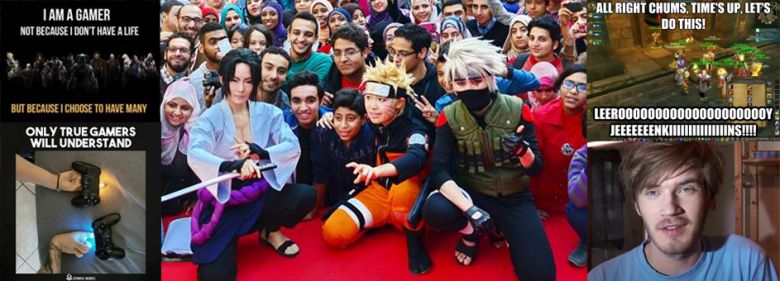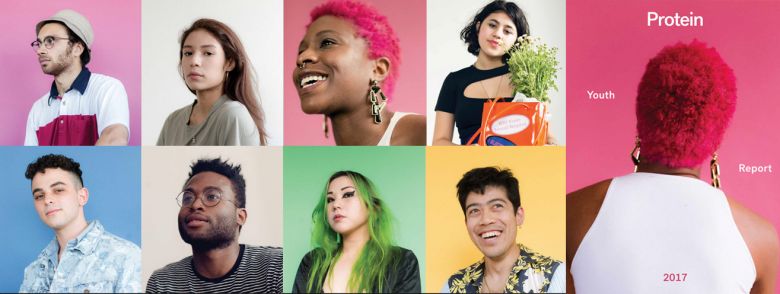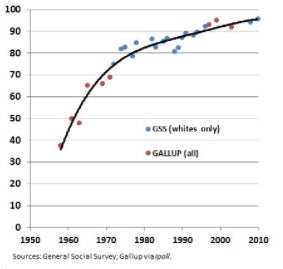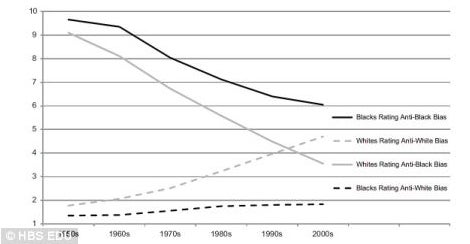This is the seventh article in a series that aims to explore how subculture has changed in the last 30 years. Read the sixth part here. New to the series? Click here to read part one.
This article looks at a number of themes:
- Is subculture in decline? Or are they just different? The panel give their views.
- Neotribalism
- Subculture becoming culture
- Semiotics and irony
- Social pluralism
- Can subculture learn?
- What’s the next subculture?
Two sections are specifically addressed by a panel of experts who add their insights. These experts are people I know from a career in the music media and marketing. All have unique perspectives and insights to offer as part of their working lives, hobbies and interests, or both. Read mini-bios of them in the The Death Of Subculture part 1: the changing role of subculture in 21st century Britain.
Subcultures as we know them are in decline because the amount of shared influential experiences is in decline
Insider perspective: Do you think subcultures are in decline? Or are they just different?
Those who say: subcultures ARE in decline
“Subcultures are in decline. There is no true longevity in music anymore. We live in a fast food nation of music now. The album is basically a redundant format; people can just download what they want and move on rather than really sticking with an album/band for the whole journey. Trends take commitment and without the longevity you can’t form subcultures.”
Jon Luis Jones, Co-director of press
“Subcultures are probably in decline. Going back some years, nu-metal became a wildly popular subculture; but at the same time it united at least two disparate subcultures, hip hop and metal – and on top of that, to a degree, pop music. So while subcultures do exist, they are not, I don’t think, quite so isolated from one another. People don’t need to be quite so tribal.
“Music is no longer the vanguard it once was. It’s being replaced by forms that are even more immediate, mostly social media. Nowadays, people post online what they might once have put into a song. Similarly, the information people once got from, say, The Clash or Public Enemy, they would get from a blog today.
Ian Winwood
“Subcultures as we know them are in decline because the amount of shared influential experiences is in decline. How often does the entire country sit down in front of the television or radio to collectively experience something? Big sporting events aside, it just doesn’t happen.
“Would the Sex Pistols have had the same impact and made punk such a huge cultural explosion, without the Bill Grundy incident being seen by so many people? We have fewer shared experiences as a society now, so it’s not surprising that fewer people are moved and motivated by the same things.
“Subcultures still exist, but they do so in a bubble, untouched by wider society.
“For example, take tech-metal movement. There is no band in the movement that would be recognisable to a mainstream audience, but it is able to exist as an island to a small group of obsessive fans. So much so that there are festivals made up solely of a type of music that is niche even within wider metal communities. The level of excitement that was generated by this small group would previously have translated into some interest from the mainstream, but in this era it remains utterly untouched.”
Stephen Hill, journalist
“Decline, decline, decline. For the last few years ‘subcultures’ seem to be exclusively fashion trends rather than discernible tribes. Subcultures seem to be gently smoothing out.”
Ali Divers, manager
“Subcultures are in decline as culture is becoming more homogenous. Subcultures now pick elements from different areas. As a teenager I used to have to make my clothes, now you can go online, click and it’s on your doorstep the next day. Today, you don’t have to culturally invest to belong. It doesn’t really feel like there is anything to fight for anymore.”
Julie Weir, Label Head
“Subculture is is both changing and declining, and the reasons for this are many.
- Major record labels are more powerful than ever, with fewer (truly) independent labels existing [due to the decline of tangible music sales].
- The major labels want to make money with less risk so pop acts have tracks written by the same team of songwriters. Music isn’t as politically charged. When all artists just sing about heartbreak and dancing it has nothing of societal or philosophical importance to say which makes it hard to create a subculture.
- Due to major labels taking less risk, the disappearance of development deals means it is very hard for working class acts to reach a stage where they would even get signed. The best art is created in times of hardship and these are the types of artist which are more likely to create long-lasting subcultures. But only those privileged enough to have funding, will be able to get to the point of having a following and online presence. And only these acts are likely to obtain the record deals and get their art heard by the masses.
Ross Gidney, Music Supervisor
Subculture isn’t life and death anymore, it’s just having fun in the dressing-up box of history
“Subcultures are undoubtedly in decline. Subculture isn’t life and death anymore, it’s just having fun in the dressing-up box of history. People forget, but punk was as serious as cancer to those that were there. Wearing those clothes you ran the gauntlet of universal condemnation and occasional violence. Adults were beating up children because a working class kid who’d had a couple of lagers was goaded into swearing on television.
“Subcultures moulded where we are now. The job’s done, different generations get on now, subculture loosened us up as a society.”
Ian Fortnam, Reviews Editor
“Perhaps the biggest affect on culture in the last 30 something year is the idea of sampling. It crept into music through hip-hop, house, jungle and electronic music but it subsequently crept into high street fashion with the idea of ‘edits’ – mix-and-match genre fashions: 90s lumberjack shirt meets 80s leggings topped off with 00s knitted sneakers. We live in an era of ‘sampling’. We sample highlights of culture we love – and then remix it. It’s as if the iPod generation embraced the shuffle button and applied it to everything. Food fusions, fashion edits, music sampling.”
Russ Tucker, Creative Director

Sampling: The Beatles used various incongruous samples on Sgt Peppers; arguably the first hip hop record (1979) Rapper’s Delight’s backing track is made up of portions of Chic’s Good Times; Afrika Bambaataa’s Planet Rock (1982) uses Krafwerk’s Trans Europe Express; in the mid-80s Steinski started creating tracks using ONLY samples, from a variety of sources; De La Soul producer Prince Paul started creating structured songs using many samples; Norman Cook has made a career from building songs around samples, under the names like Beats International, Pizzaman and Fatboy Slim.
Those who say: fragmentation and blurred lines
“I think people enjoy being ‘different’, so subcultures will probably always survive. Big subcultures are now split into sub-subcultures. Y ou’re not just into metal, you’re into stoner or black metal or metalcore or whatever. And there’s tension between those smaller sects and the larger subculture. The internet may have brought us all together, but that only makes us all want to be different even more. It’s much easier to find like-minded people, revel in your own niche and feel superior to everyone else.”
Scott Rowley, Editor-In-Chief
“Subcultures are far more fragmented than they used to be and social media has meant they don’t need to be geographically linked [like they used to me]. You won’t see gangs of Mods and Skinheads at the shopping centre on a Saturday anymore, but that doesn’t mean there aren’t people with shared interests in music, style and life values meeting and talking online. The physical manifestation of the subculture is in decline, but not the tribalism itself. People these days can belong to moe than one tribe, and that is the thing that is really different.
Jon Lilley, Creative Director
youth are becoming more homogenous in appearance and outlook
Those who say: subcultures are NOT in decline
“They’re not in decline, they are just more homogenised. It is important to remember that many subcultures aren’t related to music. Cosplay is a huge global subculture but has little to do with pop music.”
Alex Burrows, Manager
“Subcultures aren’t in decline, they’re just not exclusive anymore. People were confined in the past. We were told what to do and how to dress by the media. Generation X wanted to belong and conform to a group – it was their identity. Gen Z aim to be unique – you create your own identity and don’t want to be put in a box. Subcultures exist but they are fluid. You can like afrobeat and heavy metal, but dress in Urban Outfitters.
“Generation Z’s identity has no boundaries because they don’t want to be defined as one thing. They see themselves a global citizens because they have access to any nation they want online. They dance between musical genres more than previous generations. You can be into rock but wear what you want and, to young people, it doesn’t mean you are less dedicated than the rock fans of 2007.”
Sophie K

Sophie K interviewing ’90s heavy metal titans Korn
“I don’t know that they are in decline. The numbers of kids who form subcultures is in decline. Although it’s my perception that youth are becoming more homogenous in appearance and outlook, but I’m aware that this may be down to the fact that I’m no longer 15 and hanging out at the school disco.
“I don’t think there’s really been a big new subculture since the 1980s, even then it wasn’t so much the emergence of one particular subculture as a fragmented series of youth tribes. These emerged out of boredom and affluence rather than austerity and poverty.”
Tommy Udo
I don’t think individuals in modern times feel the need to be in a pack, to be accepted.
John McMurtrie
“The internet changed everything. Why is there any need to go and meet anymore? Cyberspace is forming lots of subcultures, whether that’s online gaming in competitive multiplayer or questing together in an MMO world like Final Fantasy or World of Warcraft.
“The ‘gamer’ subculture is still around but the group has split. Hipsters have come in, like they do [always looking for the new cool thing], and tried to own the culture. Many of us sit in the ‘been doing this for years’ camp.”
Rich Berry

A huge – largely invisible to the public – gaming culture has grown in the last 30 years, with its own language, in-jokes, heroes (PewDiePie bottom right) and values (many enjoy dressing up as characters from games).
Neotribalism
One theory that looks at the changes in subculture, neotribalism, says that “human beings have evolved to live in tribal society, as opposed to mass society, and thus will naturally form social networks constituting new tribes.”
Individuals are no longer defined by a single tribe, they exist and belong within multiple subcultures
Why? Why did that evolve? While social evolution is different from biological evolution, the process still describes adaptation to environment. And so the process would say that we evolved because there was a need to, a need to live in a tribal society, as opposed to a mass society.
French sociologist Michel Maffesoli predicted that as the culture and institutions of modernism declined, societies would embrace nostalgia and look to the organizational principles of the distant past for guidance, and that therefore the postmodern era would be the era of neotribalism.
In 2006, McPherson, Smith-Lovin and Brasiers published a study that went further, adding there has been a general breakdown in the social structure of modern civilization due to “more frequent moves for economic reasons, longer commutes and a lack of emphasis in the media narrative on the desirability of strong friendships and community bonds.”

Photography from and cover of the 2017 Protein Youth Report
Protein’s Youth Report 2017 found that not only does mainstream culture now accept plurality, but “lifestyles are flexible not fixed. Individuals are no longer defined by a single tribe, they exist and belong within multiple subcultures. Tastes, interests and interactions are no longer secured to a single scene or locality, they move fluidly across cities, cultures and communities.
Relating to the opening statement – I don’t see subcultures in the street – the report says that “Traditional demographic markers [semiotic symbols/signals (uniforms)] are no longer sufficient when it comes to categorizing or predicting behaviours or attitudes.”
This video perfectly illustrates through parody, the ‘individualism’ of Millennials
Subculture becoming culture
“Social reintegration of individuals and, often the whole subculture, takes place through commodification or intellectual stagnation.
“As consumption of alternative cultures increases, subcultures become mainstream as the dominant culture incorporates the emergent culture through mass media – and now social media and the internet. This is how the ideologically dominant in society continuously secure popular consent to an established social order.
“The prevailing values of a society change over time as members of challenging subordinate groups are incorporated into the dominant culture, for example gay rights, The Suffragettes etc. And so social order is maintained.”
Sourced: ymresourcer.com

Justin Beiber in his Behemoth t-shirt. Polish blackened death metal band Behemoth (who remain controversial in Poland due to their ‘satanic/occult/murderous’ lyrics). Is Justin wearing it because he really likes Behemoth and wants to let everyone know that? Or has it just become a ‘meaningless’ fashion thing…?
If there are no more subcultures, does that mean there are no more battles to be fought, no more injustice, no more equality? Or is it that groups who are still ‘fighting’ for things (women’s rights, LGBT, green issues, have a different platform to do so (activism, publishing, direct action, political representation)? Maybe this is why London’s grime scene is one of the few remaining subcultures, because, as many reports indicate, young black working/under class men are still underrepresented in society and discriminated against.
If there are no more subcultures, does that mean that all subcultures have been absorbed and integrated (even assimilated) by mainstream culture? Is there is no such thing as subculture because culture itself is so inclusive and fragmented?
Bikers were once social outsiders, tarred with the brush of “the 1%” of violent motorcycle gangs of the 1940s and ‘50s. Since the 1990s, more and more men and women – from doctors to mechanics – don the HOG (Harley Owners Group) uniform (waistcoat with chapter insignia) and enjoy beer and bands at social gatherings all over the UK.
Would it be right to postulate that ‘there’s a place for everyone, that everyone has a voice’?
There are a numerous other examples of minority groups and (sometimes) associated subcultures becoming culture. This might be best shown by saying that in 1918 women won the right to vote, 99 years on, there is a Minister for Women and Equalities. The disenfranchised, downtrodden and different shouted: ‘we are valid, we want to be ourselves in this society’… and society listened.
Would it be right to postulate that ‘there’s a place for everyone…. everyone has a voice’?
Maybe the divisiveness we are being told exists in western society (Brexit, Trump) is because mainstream society now includes so many different voices that 100 years ago would not have been represented, and there would appear to be one voice. For example, the ‘hidden poverty’ of the 60s wasn’t seen by many and the UK appeared to be ‘doing well’ after the war.
As some of the panel posit, it seems that subcultures also prepare us for mainstream culture. Most members of a subculture reach 21-25 and are absorbed and/or assimilated by the dominant culture. Without knowing it, by adopting a subculture – its uniform, values and behaviour – we are learning how to do it for mainstream culture. Many people hit a certain age and simply swap the uniform and language of the subculture for that of mainstream culture.

Things we wouldn’t have seen 50 years ago: gay pride parade, MP Diane Abbot, millionaire businesswoman Deborah Meaden, ‘The Branson Factor’ casual work wear in the boardroom, comedian/actress Francesca Martinez who has cerebral palsy.
Societal pluralism
While there is significant progress still to be done on many of the following, the list shows 110 years of progress, overturned taboos, social diversity, empowerment of minorities and changing values. Don’t see this list in terms of what is still to be done, but compare to how things were 100, or even 50 years ago…
- Homosexuality (The Sexual Offenses Bill decriminalizes homosexuality in 1967)
- Ethnic minority equality and representation (Members of Parliament from ethnic minorities has more than doubled since 1987)
- Religious pluralism (This report found religious tolerance had improved from 1991 to 2008)
- Women in the workplace and conjugal roles
- Provision for single-mothers
- Reduced stigma of divorce, remarriage and ‘blended families’
- Professional dress codes becoming more casual
- Euthanasia
- Understanding of mental illness and diminishing stigma
- Paralympics (first Paralympics in 1960)
- Media pluralism
Culture becoming subculture
The list shows that some aspects of what used to be mainstream culture – homophobia, religion, racism – is now subculture. As certain parts of US society have become more socially liberal, hate groups are on the rise. The same is true in the UK with far right groups emerging every decade since the 1940s.

Percent of Americans who would vote for a qualified African American/Black person for President
This spiked in the middle of Obama’s presidency. This again supports the idea that underrepresented people (in this case neo-Nazis, KKK, skinheads) form groups for identity, legitimisation and power.


This graph shows how white Americans feel discriminated against over time
Conversely, as mainstream politics has moved from the traditional right of the Victorian era to the centre ground in the last 100 years, so far left groups and parties have declined – their voices and views reflected in government policy and society.
Semiotics and irony
Semiotics and semiology describes signs and symbols in communication. All members of a society need to understand what signs and symbols mean for the communication to work. Road signs, logos and words all work to communicate ideas based on everyone understanding the signs, symbols and rules used. Even things like tattoos and piercings can convey meaning – broad and specific.
Share
Subscribe




